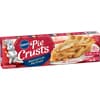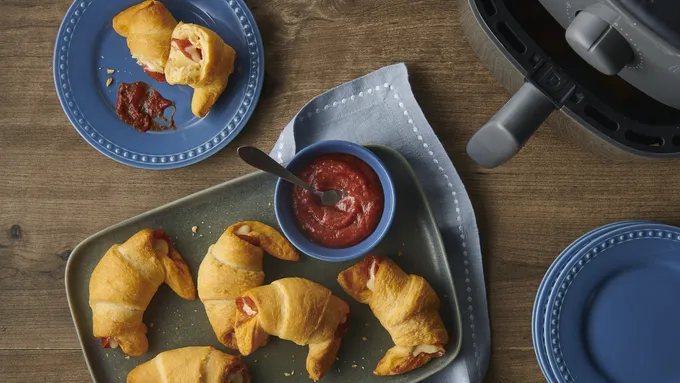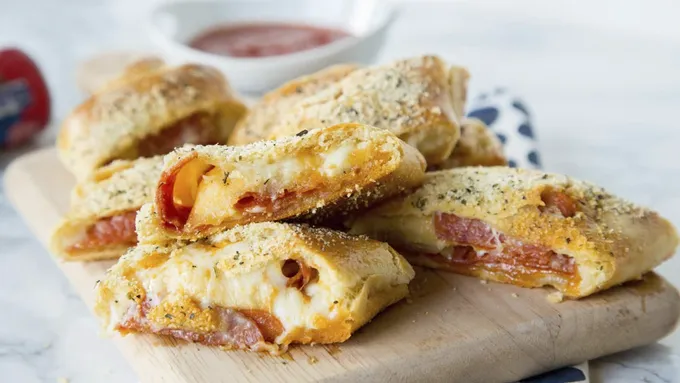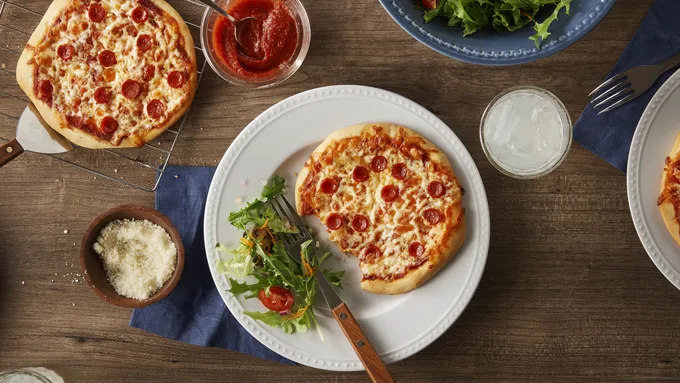Easter Pie is a rich, meat-and-cheese-filled Italian dish traditionally served on Easter. As the center of Catholicism, Italy takes the season of Lent seriously, so even lapsed Italian Catholics often still “give up” something for the period between Ash Wednesday and Easter. Traditionally, delicious Italian meats and sweets were on the chopping block, though fish and eggs were acceptable.
No matter how one chooses to practice Lent, if at all, there’s no denying this indulgent double-crusted pie is the perfect way to end any fast, diet, or time of scarcity. Nothing says rich and indulgent like a variety of Italian meats and cheeses tucked in between two layers of flaky pie crust. In Italy, this classic savory pie is so popular, it’s not just reserved for Easter. Many families make it throughout the year. Try adding it to your repertoire for Easter—or anytime!
How To Make Easter Pie
Our Easter Pie recipe uses a few shortcuts to deliver the classic flavors of the original with much less time and effort. Here’s a peek at how we make it. You can see the full list of ingredients and instructions below.
Mix the Filling
To make the base of this recipe, mix eggs and cheeses.
While traditional Italian Easter Pie uses a type of cheese called basket cheese in addition to the ricotta and other cheeses, we skipped that ingredient as it can be difficult to find unless you’re close to an Italian grocery store just before Easter. We prefer whole milk ricotta for its luxurious texture, and we chose the easy bagged blend of shredded mozzarella and provolone cheeses for simplicity. You can decide whether to grate your own Parmesan cheese or opt for the pre-grated Parmesan cheese in the shaker container. (We don’t think anyone will know the difference.)
Add the Meats
Stir the meats into the egg and cheese mixture.
An authentic Easter meat pie calls for diced Italian deli meats, but sliced versions of salami, prosciutto, and pepperoni are readily available in most grocery stores. We’re calling for those and chopping them up for this simplified recipe.
Prepare the Crusts and Add the Filling
Press one softened pie crust (saving time and making it easy by using Pillsbury™ Ready-to-Bake Pie Crusts) in a pie plate, then add filling. Top with the second crust, tuck the edges under the bottom crust and flute it. Then just make a couple of slits in the top of the crust to allow air to escape and all that’s left to do is bake!
Serving Easter Pie
Easter Pie, also known as “Pizza Rustica,” often lands on the table around lunchtime or early afternoon, but you can enjoy it any time of day.
Since the best Easter Pie is dense and filled with salty Italian deli meats and cheeses, we don’t recommend adding any extra salt, at least until you’ve tasted it first! Also, it’s nice to serve with some lighter sides, like a simple salad. Or instead of a salad for your green vegetable side, try these green beans with pearl onions and bacon. It’s a simple dish that’s ready in less than 30 minutes.
For a bigger Easter spread, you might also want to include other heartier options like potatoes. Put your slow cooker to work with these slow-cooker cheesy potatoes and ham. It comes together fast, using purchased diced ham, pre-shredded cheddar cheese, and mushroom soup.
Then just round out your meal by taking Pillsbury™ Crescent Rolls up a notch! These crescent rolls with fresh herbs use just a few ingredients, but fresh parsley, thyme, basil, and oregano add tons of flavor and color with very little effort.
Storing and Reheating Easter Pie Leftovers
Have leftover Italian Easter meat pie? You can save this yummy, savory pie in the fridge and enjoy it for days! We don’t recommend freezing your Easter Pie, as it could separate after freezing and reheating—but you can use our instructions below if freezing is absolutely necessary.
To Refrigerate (Recommended): Cut the baked, cooled pie into 8 slices and wrap each slice individually in foil. Your pie will keep well in the refrigerator for up to 4 days. Just reheat a slice in the oven whenever you need an easy meal or snack.
To Reheat from Refrigerated: Keep each individual portion in the foil. Reheat your pie in a 325°F oven for 15 to 20 minutes or until fully heated through. Using a thermometer, check that the center of each pie slice has reached at least 165°F—then you’re ready to dig in!
To Freeze: Freezing a whole baked pie? Wrap your pie in 2 layers of plastic, making sure to label and date the packaging. It will keep well in the freezer for up to 2 months. To freeze in individual portions instead, cut it into 8 slices and arrange them on a rimmed baking sheet. Freeze the pie slices for at least 4 hours or until firm, then wrap each frozen slice in plastic and place them in a resealable plastic bag. Label and date the packaging and freeze your pie slices for up to 2 months.
To Reheat from Frozen: If you’ve frozen a full pie, remove it from the freezer, and place it in the refrigerator to thaw overnight. Once your pie has thawed, unwrap the plastic wrap and bake it in a 350°F oven for 20 to 25 minutes or until heated through. If you froze your pie in individual slices, let the slices thaw overnight in the fridge on a paper towel-lined baking sheet. The next day, cover each individual slice in foil and bake them at 350°F for 15 to 20 minutes. Using a food thermometer, make sure each portion of your pie has reached a safe internal temperature of at least 165°F.
Recipe Variations and Substitutions
Now that you’ve made our simple version of Easter Pie, feel free to make it your own! This classic Italian recipe is super adaptable, but there are a few keys to making successful substitutions.
Keep Filling Amounts the Same: This pie is quite full already, so whether you’re adding different meats, cheeses, or other ingredients, keep the total amount of filling the same. For example, if you want to use ham, turkey, roast beef, capicola, or mortadella, swap it for the same amount of salami, prosciutto, or pepperoni. This is the same for adding other ingredients, like veggies. For best results, replace instead of simply adding.
Only Use Cooked Ingredients: Whether subbing in Italian sausage or spinach, be sure to cook ingredients first. Raw meats might not safely cook through during baking, and they definitely wouldn’t be deliciously browned. Plus, even tender veggies like greens and onions release liquid during cooking, which will affect the texture and thickness of the filling.
Dry Ingredients First: If using marinated items like roasted red peppers or olives, pat them dry before adding to the filling.
More Easter Recipes
Need more inspiration for your Easter feast? Look no further!
Easy Honey Ham: If you don’t already have a favorite Easter ham recipe, this one is a great one to try. It only has four ingredients and it’s got a 5-star rating!
Cheddar-Bacon Au Gratin Potatoes: Another of Pillsbury’s best-loved recipes that ticks all the boxes for a perfect Easter side. These potatoes start with a creamy, meaty, cheesy base, then get topped with crunchy panko and a sprinkle of green onions.
Bacon-Cheddar Slab Quiche: With a few simple ingredients and a quick prep time, this crowd-friendly quiche is a holiday classic that’s easy enough for any day. It’s Easter Pie’s American cousin.
Easy Homemade Monkey Bread: A sweet treat with cinnamon- and sugar-coated Pillsbury™ biscuits, brown sugar, butter, raisins, and walnuts, this yummy dessert will have your guests coming back for seconds.
Frequently Asked Questions
Watch Video
Easter Pie
- Prep Time 25 min
- Total 1 hr 20 min
- Ingredients 8
- Servings 8
Ingredients
- 3 eggs, slightly beaten
- 16 oz whole milk ricotta cheese
- 2 cups shredded mozzarella and provolone blend cheese (8 oz)
- 1/4 cup grated Parmesan cheese
- 4 oz sliced salami, chopped (1 cup)
- 3 oz sliced prosciutto, chopped (3/4 cup)
- 3 oz sliced pepperoni (from 6-oz pkg), chopped (3/4 cup)
- 1 box (14.1 oz) refrigerated Pillsbury™ Pie Crusts (2 Count), softened as directed on box
Instructions
-
Step1Heat oven to 425°F. In large bowl, mix eggs, ricotta cheese, shredded mozzarella and provolone cheese blend, and grated Parmesan cheese.
![]()
-
Step2Stir salami, prosciutto, and pepperoni into egg mixture.
![]()
-
Step3Place 1 pie crust in ungreased 9-inch glass pie plate. Press firmly against side and bottom. Spoon egg mixture into crust-lined pie plate.
![]()
-
Step4Top with second crust. Wrap excess top crust under bottom crust edge, pressing edges together to seal; flute. Cut several slits in top crust.
![]()
-
Step5Bake 20 minutes; cover edge of crust with 2- to 3-inch wide strips of foil to prevent excessive browning. Bake an additional 20 to 25 minutes or until center is done (at least 165°F) and crust is golden brown. Cool 10 minutes before serving.
![]()
Nutrition
Nutrition Facts
Serving Size: 1 Serving
- Calories
- 540
- Calories from Fat
- 330
- Total Fat
- 37g
- 56%
- Saturated Fat
- 20g
- 99%
- Trans Fat
- 1/2g
- Cholesterol
- 155mg
- 51%
- Sodium
- 1140mg
- 47%
- Potassium
- 320mg
- 9%
- Total Carbohydrate
- 30g
- 10%
- Dietary Fiber
- 0g
- 0%
- Sugars
- 2g
- Protein
- 22g
% Daily Value*:
- Vitamin A
- 10%
- 10%
- Vitamin C
- 0%
- 0%
- Calcium
- 35%
- 35%
- Iron
- 15%
- 15%
Exchanges:
1/2 Starch; 0 Fruit; 1 1/2 Other Carbohydrate; 0 Skim Milk; 0 Low-Fat Milk; 0 Milk; 0 Vegetable; 0 Very Lean Meat; 0 Lean Meat; 3 High-Fat Meat; 2 1/2 Fat;Carbohydrate Choice
2Tips from the
Pillsbury Kitchens
- tip 1
- tip 2













